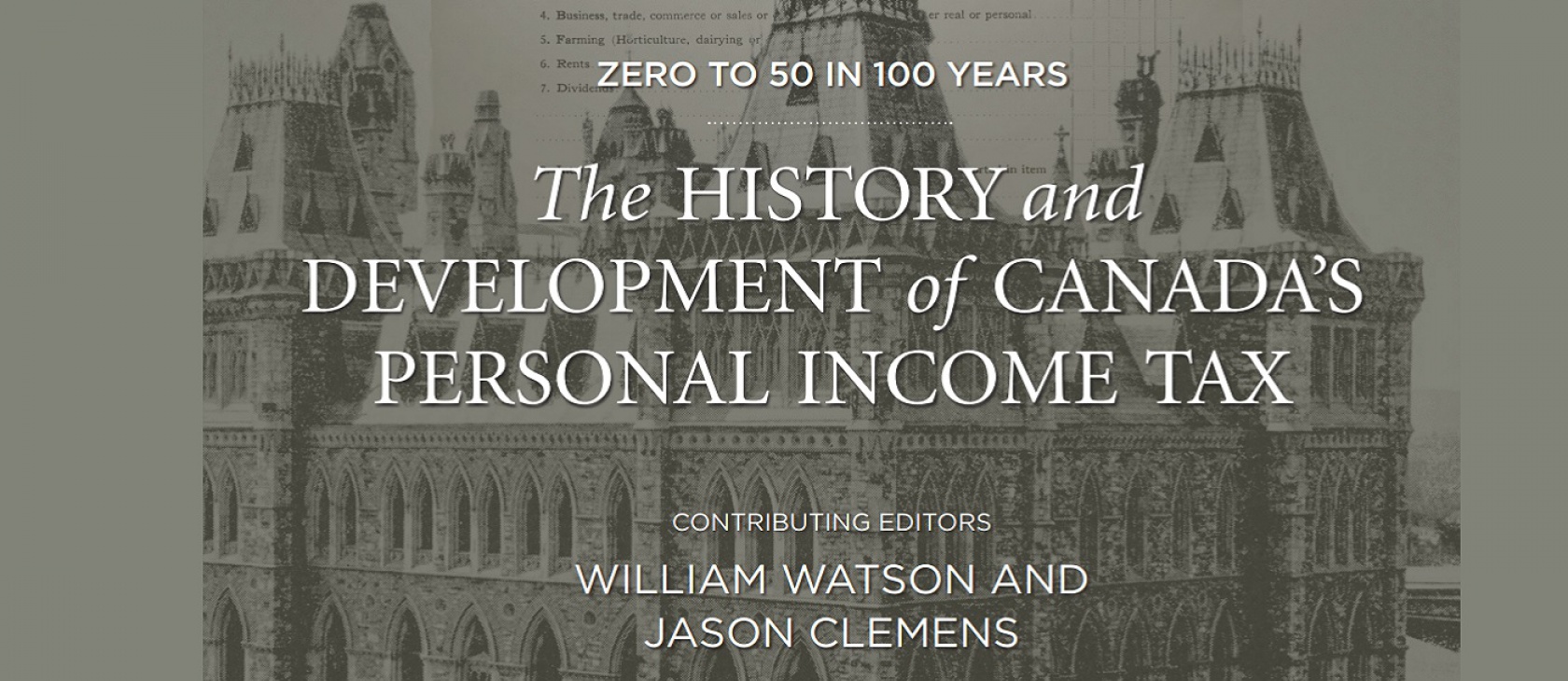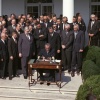Like the United States, Canada instituted its federal income tax 100 years ago. In the states, the progressive income tax was a demand of the original Populist movement and, after being deemed unconstitutional, was adopted into the U.S. Constitution in 1913. But Canada – which marks the 100th anniversary of its income tax this year – saw the tax as a patriotic contribution to war. The origins and unforeseen growth of the personal income tax is the subject of a new collection of essays compiled by the Fraser Institute released on Thursday: From Zero to 50 in 100: The History and Development of Canada’s Personal Income Tax. (The full book may be downloaded as a PDF here.)
As the book illustrates, in its present form, the income tax discourages economic growth, investment, and initiative while punishing far more than those who pay Ottawa’s tax assessments each year.
War and “the conscription of wealth”
Unlike the United States, where the graduated income tax had been a matter of mere class contention and sectionalism, Canada adopted a Personal Income Tax (PIT) against the backdrop of physical warfare. From the first, the PIT came into policy cloaked in the guise of national unity. After three years of the Great War, Canada turned to conscription to fill its military needs. The Military Service Act passed in August 1917, and over the next two years 100,000 Canadian men aged 20 to 45 would be drafted. The armed forces swelled to an incredible 500,000 out of a total population of eight million.
The idea of conscripting able-bodied men to fight and die in World War I intensified calls for a “conscription of wealth.” Yet Sir Thomas White, the Finance Minister and a Conservative, rebuffed those efforts for years. William Watson of McGill University writes:
What changed Minister White’s mind? In a word: conscription. In the summer of 1917, the Commons debated and approved compulsory military service, which until then had been avoided. Quebec separation aside, conscription was the most divisive issue Canadian politics ever contended with. In the election of December 1917, it badly split both the Liberal Party and the country. Both morally and practically, however, conscription was key to the income tax.
Sir White finally bowed to pressure, introducing the Personal Income Tax (PIT) as a more modest alternative to levying a tax on private fortunes. The PIT received Royal Assent two months after its introduction, on September 20, 1917.
The “War Income Tax,” as it was known, affected few Canadians. Only two to eight percent of citizens had to file and, as Lakehead University’s Livio Di Matteo points out in his essay, the personal tax exemption in inflation-adjusted dollars was more than double what it is today.
In both the United States and Canada, the Roaring Twenties brought lower tax rates and prosperity. As U.S. Treasury Secretary Andrew Mellon slashed the top U.S. tax rate from 77 percent to 29 percent, Canadian Finance Minister James Robb cut the PIT by more than 60 percent in 1926 and 1927. In a perceptive essay, Watson sleights Robb for missing the opportunity to do away with the income tax altogether after the war, as Sir Thomas White had suggested upon its introduction.
Perhaps the most important service rendered by this book is the way it documents the wealth-destroying aspects of the personal income tax.
Yet the same historical development would mainstream the income tax as part of everyday life on both sides of the U.S-Canadian border: World War II. The original, four percent PIT rate ballooned to 44 percent, personal withholding began in 1943, and eligibility expanded as the state sought funds for the war effort. While the postwar years saw taxes pared back, they have substantially exceeded their pre-war level in Ottawa and Washington. After the war, Canada dropped the name “Wartime Income Tax” and with it the pretense that the system was tied to just one-half of the welfare/warfare state.
Taxes “a psychological barrier to greater effort”
Sounder minds tried to promote economic sanity in both nations, at roughly the same time. As Mellon lauded private industry, Robb said his 1927 tax cut would allow “moneys which otherwise would come into the public coffers [to be] released for the use of the individual; the development of the country is encouraged; the cost of production in our industries is reduced, and avenues for an increase of business are created.”
As John F. Kennedy said lightening the tax burden would “increase incentives and the availability of investment capital,” Prime Minister John Diefenbaker appointed a commission that would propose cutting individual tax rates. In 1966, the Carter Commission report said, “We think there is a psychological barrier to greater effort, saving and profitable investment when the state can take more than one-half of the potential gain.” (Emphasis added.)
Perhaps the most important service rendered by this concise, readable report from the Fraser Institute is the way it documents the wealth-destroying aspects of the personal income tax.
Taxes destroy $7 for every $1 raised in Ontario
Delineating how the income tax consumes wealth is vital, because the opportunity costs are not always visible. Bev Dahlby of the University of Calgary calculates that every dollar of additional taxation in Ontario costs the province nearly $7 in direct and indirect costs: reduced economic activity, fewer jobs, etc. That is, the benefits of any government program requiring additional taxes must be more than seven-to-one to justify transferring funds from the private to the public sector. “The list of such projects,” the report notes, “can’t be very long.” (Dahlby found the marginal cost of public funds in other provinces is no lower than two-to-one.)
This is, there is a 700 percent reduction in real wealth – real living standards – every time politicians pilfer a loonie out of private hands since, as Friedrich Hayek noted, technocrats by definition cannot have sufficient information to know how to invest it better than individuals in the free market.
These costs fall, not only on businesses, but individuals. Compliance costs “represent about $501 per Canadian household,” or $217 for each individual, according to Watson. And as he notes, these fall heaviest on the poor.
Why Christians should care
If people of faith are called to care for the poor, we must support policies that produce less of them. Faith leaders such as Pope Francis rightly emphasize the importance of employment for young people – not just to meet their material needs but to give them an inherent sense of dignity, encourage family formation, and allow them to express and develop their God-given talents…and to share for the life of the world. The flourishing of each individual person requires investment - and in the economic sense, this is referred to as capital. Zero to 50 in 100 demonstrates in Canada what Richard Teather recently documented in these pages: Pope Francis’ desired outcome is best accomplished in countries that have lower taxes and less government spending. The book also details how the economic effects of war last long after an armistice has been signed. Helpfully, it concludes with two chapters of proposals to overhaul the Canadian tax system to enhance wealth creation.
This new book provides expert data and a broader perspective for those of us who argue for a free and virtuous society in the transatlantic sphere. You may download the PDF here.














